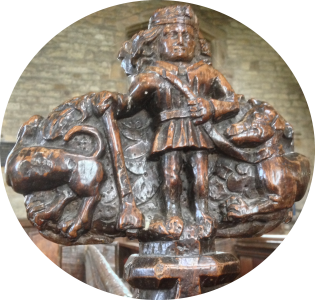I am casting my accounts because my business year has just ended. My accounting year ends on 31 May, not our UK fiscal new year’s day of 5th April, which is of course ‘Old Lady Day’. Until 1752, the New Year according to the traditional calendar was 25th March – the Annunciation of the Blessed Virgin Mary, commonly known as Lady Day – but when the calendar was adjusted to bring Britain into line with continental Europe eleven days in September were jumped and the financial year-end slipped by the same interval to 5th April.

Assembling the figures has reminded me of the narrative of my work over the past year. It began with teamwor k as the Duchess of Rutland’s book Capability Brown at Belvoir, designed by Nick McCann, went to press. My role, supporting the Duchess and her co-author Jane Pruden, was digging for new nuggets in the archives at Belvoir Castle; if you want to read them, you’ll have to buy the book!
k as the Duchess of Rutland’s book Capability Brown at Belvoir, designed by Nick McCann, went to press. My role, supporting the Duchess and her co-author Jane Pruden, was digging for new nuggets in the archives at Belvoir Castle; if you want to read them, you’ll have to buy the book!
My year ended similarly contributing to the Duchess’ speeches for her lecture tour in America. One of the great things about archives is that they keep on giving: new questions for new audiences bring out new answers. It’s a dialogue.

 Rather fewer family historians hired me last year (are we still in a recession, or is my advertising missing this target?), but the ones who did brought me some interesting puzzles deciphering wills, feoffments, petitions, pleadings, and court rolls from the 14th to the 19th centuries. Translating for local historians continues to be significant. I say ‘local’, but as they send me digital photographs to work from, my projects have ranged geographically from south Devon to Lincolnshire, and chronologically from the 14th to the 17th centuries. Thank you all, John, Mike, William, Peter, Philip, Keith; I shall leave you to tell your own stories when you publish your work. My translation of the Norton Court Rolls was published by the Hertfordshire Records Society last year – the result of an HLF grant to the Norton Community Archaeology Group over five years. Something new this year has been transcribing and translating the mediaeval Bourne Chronicle for the College of Arms, telling the story of Hereward the Wake.
Rather fewer family historians hired me last year (are we still in a recession, or is my advertising missing this target?), but the ones who did brought me some interesting puzzles deciphering wills, feoffments, petitions, pleadings, and court rolls from the 14th to the 19th centuries. Translating for local historians continues to be significant. I say ‘local’, but as they send me digital photographs to work from, my projects have ranged geographically from south Devon to Lincolnshire, and chronologically from the 14th to the 17th centuries. Thank you all, John, Mike, William, Peter, Philip, Keith; I shall leave you to tell your own stories when you publish your work. My translation of the Norton Court Rolls was published by the Hertfordshire Records Society last year – the result of an HLF grant to the Norton Community Archaeology Group over five years. Something new this year has been transcribing and translating the mediaeval Bourne Chronicle for the College of Arms, telling the story of Hereward the Wake.

Work on legal matters continues for several clients, and of course I shall respect their confidentiality here, whether or not strictly sub judice. Likewise support for academics who will be publishing the results of our collaborations in monographs, articles and theses in due course. It’s always satisfying to know I had some input early on when a book is published or TV programme goes out. Last year it was the Channel 4 Alan Titchmarsh series about Capability Brown; this year it will be Leanda de Lisle’s book about Charles the First and Henrietta Maria, and a couple of Who do you think you are? shows – but of course the Wall to Wall production team will never tell you whose!
peter@peterfoden.com

“One of the great things about archives is that they keep on giving: new questions for new audiences bring out new answers. It’s a dialogue.” I love that!
LikeLiked by 1 person
Isn’t that why we do what we do? We unlock the archives and let the conversations continue…
LikeLike
So love your nuggets and they don’t damage my teeth!
LikeLiked by 1 person
Thank you Rafiki 🙂
Oddly, I am simultaneously looking at my own year-end accounts and at Capability Brown’s. Despite the 240 year time-lapse, I find his far easier to read and understand.
LikeLike